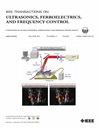Feasibility of Hologram-Assisted Bilateral Blood–Brain Barrier Opening in Non-Human Primates
IF 3
2区 工程技术
Q1 ACOUSTICS
IEEE transactions on ultrasonics, ferroelectrics, and frequency control
Pub Date : 2024-08-28
DOI:10.1109/TUFFC.2024.3451289
引用次数: 0
Abstract
Focused ultrasound (FUS) and microbubbles facilitate blood-brain barrier opening (BBBO) noninvasively, transiently, and safely for targeted drug delivery. Unlike state-of-the-art approaches, in this study, we demonstrate for the first time the simultaneous, bilateral BBBO in non-human primates (NHPs) using acoustic holograms at caudate and putamen structures. The simple and low-cost system with a single-element FUS transducer and 3-D printed acoustic hologram was guided by neuronavigation and a robotic arm. The advantages of holograms are transcranial aberration correction, simultaneous multifocus and high localization, and target-independent transducer positioning, defining a promising alternative for time- and cost-efficient FUS procedures. Holograms were designed with the k-space method by time-reversal techniques. T1-weighted MRI was used for treatment planning, while the computed tomography (CT) scan provided the head tissues acoustic properties. For the BBBO procedure, a robotic arm allowed transducer positioning errors below 0.1 mm and 0.1°. Following positioning, 0.5–0.6-MPa, 513-kHz microbubble-enhanced FUS was applied for 4 min. For BBBO assessment, Post-FUS T1-weighted MRI was acquired, and contrast enhancement indicated bilateral gadolinium extravasation at both caudate or putamen structures. The two BBBO locations were separated by 13.13 mm with a volume of 91.81 mm3 in the caudate, compared with 9.40 mm with a volume of 124.52 mm3 in simulation, while they were separated by 21.74 mm with a volume of 145.38 mm3 in the putamen and compared with 22.32 mm with a volume of 156.42 mm3 in simulation. No neurological damage was observed through T2-weighted and susceptibility-weighted imaging. This study demonstrates the feasibility and safety of hologram-assisted neuronavigation-guided-FUS for BBBO in NHP, providing thus an avenue for clinical translation.全息图辅助非人灵长类双侧血脑屏障开放的可行性。
聚焦超声(FUS)和微气泡可以无创、瞬时、安全地促进血脑屏障开放(BBBO),从而实现靶向给药。与最先进的方法不同,在本研究中,我们首次在非人灵长类动物(NHP)中使用声全息图对尾状核和普鲁塔门结构同时进行双侧血脑屏障开放。该系统操作简单、成本低廉,配有单元件 FUS 传感器和 3D 打印声全息图,由神经导航和机械臂引导。全息图的优势在于经颅像差校正、同时多焦点和高定位,以及与目标无关的换能器定位,为省时、省钱的 FUS 手术提供了一种有前途的替代方法。全息图是通过时间反转技术用 k 空间方法设计的。T1 加权核磁共振成像用于治疗规划,而 CT 扫描提供了头部组织的声学特性。在 BBBO 手术中,机械臂可使换能器的定位误差低于 0.1 毫米和 0.1°。定位后,应用 0.5-0.6-MPa 513-kHz 微气泡增强 FUS 4 分钟。为了评估BBBO,在FUS后进行了T1加权核磁共振成像,对比度增强显示双侧尾状体或普坦结构均有钆外渗。在尾状体,两个BBBO位置之间相距13.13毫米,体积为91.81立方毫米,而在模拟情况下相距9.40毫米,体积为124.52立方毫米;在丘脑,两个BBBO位置之间相距21.74毫米,体积为145.38立方毫米,而在模拟情况下相距22.32毫米,体积为156.42立方毫米。通过 T2 加权和感度加权成像,未观察到神经损伤。这项研究证明了全息图辅助神经导航引导的射频消融术治疗 NHP BBBO 的可行性和安全性,从而为临床转化提供了途径。
本文章由计算机程序翻译,如有差异,请以英文原文为准。
求助全文
约1分钟内获得全文
求助全文
来源期刊
CiteScore
7.70
自引率
16.70%
发文量
583
审稿时长
4.5 months
期刊介绍:
IEEE Transactions on Ultrasonics, Ferroelectrics and Frequency Control includes the theory, technology, materials, and applications relating to: (1) the generation, transmission, and detection of ultrasonic waves and related phenomena; (2) medical ultrasound, including hyperthermia, bioeffects, tissue characterization and imaging; (3) ferroelectric, piezoelectric, and piezomagnetic materials, including crystals, polycrystalline solids, films, polymers, and composites; (4) frequency control, timing and time distribution, including crystal oscillators and other means of classical frequency control, and atomic, molecular and laser frequency control standards. Areas of interest range from fundamental studies to the design and/or applications of devices and systems.

 求助内容:
求助内容: 应助结果提醒方式:
应助结果提醒方式:


